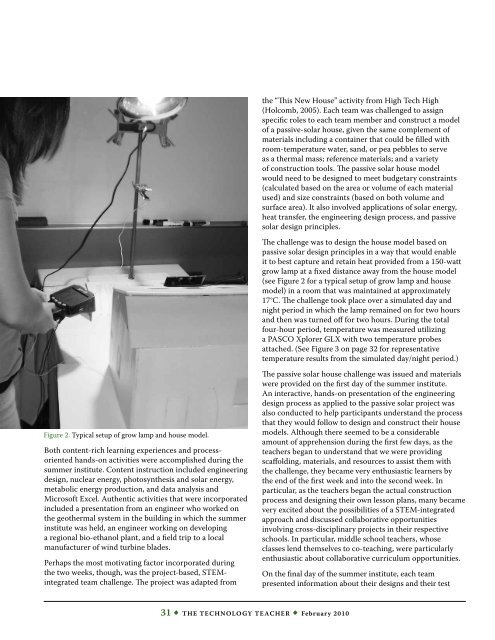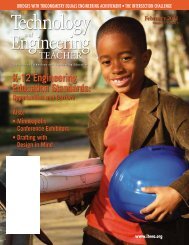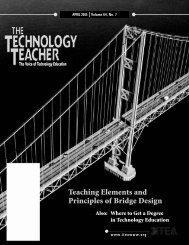February - Vol 69, No 5 - International Technology and Engineering ...
February - Vol 69, No 5 - International Technology and Engineering ...
February - Vol 69, No 5 - International Technology and Engineering ...
You also want an ePaper? Increase the reach of your titles
YUMPU automatically turns print PDFs into web optimized ePapers that Google loves.
the “This New House” activity from High Tech High<br />
(Holcomb, 2005). Each team was challenged to assign<br />
specific roles to each team member <strong>and</strong> construct a model<br />
of a passive-solar house, given the same complement of<br />
materials including a container that could be filled with<br />
room-temperature water, s<strong>and</strong>, or pea pebbles to serve<br />
as a thermal mass; reference materials; <strong>and</strong> a variety<br />
of construction tools. The passive solar house model<br />
would need to be designed to meet budgetary constraints<br />
(calculated based on the area or volume of each material<br />
used) <strong>and</strong> size constraints (based on both volume <strong>and</strong><br />
surface area). It also involved applications of solar energy,<br />
heat transfer, the engineering design process, <strong>and</strong> passive<br />
solar design principles.<br />
The challenge was to design the house model based on<br />
passive solar design principles in a way that would enable<br />
it to best capture <strong>and</strong> retain heat provided from a 150-watt<br />
grow lamp at a fixed distance away from the house model<br />
(see Figure 2 for a typical setup of grow lamp <strong>and</strong> house<br />
model) in a room that was maintained at approximately<br />
17°C. The challenge took place over a simulated day <strong>and</strong><br />
night period in which the lamp remained on for two hours<br />
<strong>and</strong> then was turned off for two hours. During the total<br />
four-hour period, temperature was measured utilizing<br />
a PASCO Xplorer GLX with two temperature probes<br />
attached. (See Figure 3 on page 32 for representative<br />
temperature results from the simulated day/night period.)<br />
Figure 2. Typical setup of grow lamp <strong>and</strong> house model.<br />
Both content-rich learning experiences <strong>and</strong> processoriented<br />
h<strong>and</strong>s-on activities were accomplished during the<br />
summer institute. Content instruction included engineering<br />
design, nuclear energy, photosynthesis <strong>and</strong> solar energy,<br />
metabolic energy production, <strong>and</strong> data analysis <strong>and</strong><br />
Microsoft Excel. Authentic activities that were incorporated<br />
included a presentation from an engineer who worked on<br />
the geothermal system in the building in which the summer<br />
institute was held, an engineer working on developing<br />
a regional bio-ethanol plant, <strong>and</strong> a field trip to a local<br />
manufacturer of wind turbine blades.<br />
Perhaps the most motivating factor incorporated during<br />
the two weeks, though, was the project-based, STEMintegrated<br />
team challenge. The project was adapted from<br />
The passive solar house challenge was issued <strong>and</strong> materials<br />
were provided on the first day of the summer institute.<br />
An interactive, h<strong>and</strong>s-on presentation of the engineering<br />
design process as applied to the passive solar project was<br />
also conducted to help participants underst<strong>and</strong> the process<br />
that they would follow to design <strong>and</strong> construct their house<br />
models. Although there seemed to be a considerable<br />
amount of apprehension during the first few days, as the<br />
teachers began to underst<strong>and</strong> that we were providing<br />
scaffolding, materials, <strong>and</strong> resources to assist them with<br />
the challenge, they became very enthusiastic learners by<br />
the end of the first week <strong>and</strong> into the second week. In<br />
particular, as the teachers began the actual construction<br />
process <strong>and</strong> designing their own lesson plans, many became<br />
very excited about the possibilities of a STEM-integrated<br />
approach <strong>and</strong> discussed collaborative opportunities<br />
involving cross-disciplinary projects in their respective<br />
schools. In particular, middle school teachers, whose<br />
classes lend themselves to co-teaching, were particularly<br />
enthusiastic about collaborative curriculum opportunities.<br />
On the final day of the summer institute, each team<br />
presented information about their designs <strong>and</strong> their test<br />
31 • The <strong>Technology</strong> Teacher • <strong>February</strong> 2010
















